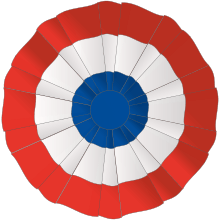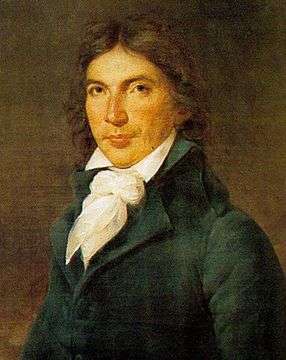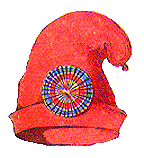Cockade of France
The cockade of France (French: Cocarde tricolore) is the national ornament of France, obtained by circularly pleating a blue, white and red ribbon. It is composed of the three colors of the French flag with blue in the center, white immediately outside and red on the edge.

History



The French tricolor cockade was devised at the beginning of the French Revolution. On 12 July 1789 – two days before the storming of the Bastille – the revolutionary journalist Camille Desmoulins, calling on the Parisian crowd to revolt, asked the protesters what color to adopt as a symbol of the revolution, proposing either green (representing hope) or the blue of the American revolution, symbol of freedom and democracy. The protesters responded "The green! The green! We want green cockades!"[1] Desmoulins then took a green leaf from the ground and pinned it to his hat.[1] However, the green was abandoned after just one day because it was also the color of the king's brother, the reactionary Count of Artois, later King Charles X.[2]
The following day, 13 July, an opportunity arose to create a cockade with different colors when those bourgeois who hoped to limit revolutionary excesses established a citizen militia.[3] It was decided that the militia should be given a distinctive badge in the form of a two-colored cockade in the ancient colors of Paris, blue and red.[3]
On 17 July, King Louis XVI went to Paris to meet the new French National Guard: its members wore the blue and red cockade of the militia, to which it would appear that the Marquis of Lafayette, commander of the Guard, had added a white band representing loyalty to the Sovereign.[4] Louis XVI put it on his hat and – with some reluctance – approved the appointment of the revolutionary Jean Sylvain Bailly as mayor of Paris, and the formation of the National Guard led by Lafayette.[5] Thus was born the French tricolor cockade. On the same day, the Count of Artois left France, along with members of the nobility supportive of absolute monarchy.[6]
The tricolor cockade became the official symbol of the revolution in 1792, with the three colors now said to represent the three estates of French society: the clergy (blue), the nobility (white) and the third estate (red).[2] The use of the three colors spread, and a law of 15 February 1794 made them the colors of the French national flag.[4]
From August 1789, Italian demonstrators in sympathy with the French revolution began to use simple cockades of green leaves inspired by the primitive French cockade. From these evolved the red, white and green Italian tricolor cockade.[7]
Use
Use on institutional vehicles
Decree no. 89-655 of 13 September 1989 forbids the use of the tricolor cockade on all land, sea and air vehicles, with the following exceptions:[8]
- by the president of the French Republic;
- by members of the government of France;
- by members of French Parliament;
- by the president of the Constitutional Council;
- by the vice president of the Council of State;
- by the President of the Economic, Social and Environmental Council;
- by prefects in their own departments, and by sub-prefects on official duties in their arrondissements.
The use of the tricolor cockade is not permitted for mayors' vehicles, and offenders risk up to one year's imprisonment and a fine of €15,000.[9]
Use on state planes
The use of the cockade on French military aircraft was first mandated by the Aéronautique Militaire in 1912, and subsequently became widespread during World War I.[10][11] The French practice inspired the adoption of a similar roundel (with colours reversed) by the British Royal Flying Corps, and of comparable insignia by other nations. Cockades were, and still are, painted on the aircraft fuselages as the primary military aircraft insignia of the French Air Force; modified designs are used for other French government aircraft.[11]
Cockades continue to be used on French state aircraft.[12] After World War II a yellow border was added to the cockade, which was removed in 1984.[13]
Other uses
The tricolor cockade is also used on certain elite uniforms, both military and civilian, which include headwear decorated with it.[14][15] It is likewise an attribute of Marianne, the national allegorical representation of France, who is conventionally depicted wearing a Phrygian cap, sometimes decorated with a tricolor cockade.[16] The cockade appears on mayors' badges;[17] and on the sash worn by Miss France.[18]
See also
Citations
- "Giovani del terzo millennio, di Giacomo Bolzano" (in Italian). Retrieved 9 March 2017.
- "Il verde no, perché è il colore del re. Così la Francia ha scelto la bandiera blu, bianca e rossa ispirandosi all'America" (in Italian). Retrieved 9 March 2017.
- "Presa della Bastiglia, il 14 luglio e il rosso della first lady messicana Angelica" (in Italian). Retrieved 9 March 2017.
- "Le drapeau français - Présidence de la République" (in French). Retrieved 9 March 2017.
- "Le Mystère de la Cocarde" (in French). Retrieved 9 March 2017.
- Antonia Fraser, Marie Antoinette: the Journey, 2002, pp. 113–116.
- Ferorelli, Nicola (1925). "La vera origine del tricolore italiano". Rassegna storica del Risorgimento (in Italian). 12 (fasc. 3): 668.
- "Décret n°89-655 du 13 septembre 1989 relatif aux cérémonies publiques, préséances, honneurs civils et militaires" (in French). Retrieved 9 March 2017.
- "Apposition de la cocarde tricolore sur les véhicules des élus locaux" (in French). Retrieved 9 March 2017.
- Kershaw, Andrew (1971). The First War Planes: Friend Or Foe, National Aircraft Markings. BCP Publishing. pp. 41–44.
- Patoz, Jacques; Saint-Ouen, Jean-Michel (1999). L'Armée de l'air (in French). Méréal. ISBN 978-2-84480-017-6.
- "La cocarde nous fait toute une histoire: évolution de la cocarde d'aviation française (1912–aujourd'hui)" (in French). Retrieved 11 March 2017.
- Ehrengardt, Christian J. (1983). "La chasse française en Afrique du nord 1942-1945" (in French). 53: 21, 24, 29. Cite journal requires
|journal=(help) - "La TEnue de TRAdition (TETRA)" (in French). Archived from the original on 13 September 2016. Retrieved 10 March 2017.
- "Paris Politecnico: Qual è il più breve del mondo un soprannome?" (in Italian). Archived from the original on 12 March 2017. Retrieved 10 March 2017.
- "1944 - 2008 - Les représentation de la Marianne républicaine sur les timbres" (in French). Retrieved 10 March 2017.
- "L'insigne des maires" (in French). Retrieved 10 March 2017.
- "Miss France: ce soir, je serai la plus belle" (in French). Retrieved 10 March 2017.
| Wikimedia Commons has media related to Cockades of France. |